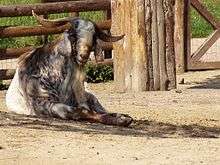Anglo-Nubian goat
The Anglo-Nubian is a British breed of domestic goat. It originated in the nineteenth century from cross-breeding between native British goats and a mixed population of large lop-eared goats imported from India, the Middle East and North Africa.[2]:356 It is characterised by large, pendulous ears and a convex profile. It has been exported to many parts of the world, and is found in more than sixty countries.[3] In many of them it is known simply as the Nubian.[3]
 | |
| Conservation status | FAO (2007): not at risk[1]:145 |
|---|---|
| Other names | Nubian |
| Country of origin | United Kingdom |
| Distribution | more than sixty countries |
| Use | dual-purpose, meat and dairy |
| Traits | |
| Weight | |
| Height | |
| |

History
The Anglo-Nubian breed originated in England between 1920 and 1930 as a cross between the Old English milch goat and imported bucks,[4] including Zariby and Nubian, imported from India, and Egypt.
It was first exported to the United States in 1909.[5]:8
Characteristics
The Anglo-Nubian is large and carries more flesh than other dairy breeds. The breed standard specifies large size, markings can be any colour, the ears are long and pendulous.
Like most dairy goats, they are normally kept hornless by disbudding within approximately two weeks of birth.
Use
The Anglo-Nubian is a dual-purpose goat. It produces on average 4.5-8% butterfat.[6]
References
| Wikimedia Commons has media related to Anglo-Nubian. |
- Barbara Rischkowsky, D. Pilling (eds.) (2007). List of breeds documented in the Global Databank for Animal Genetic Resources, annex to The State of the World's Animal Genetic Resources for Food and Agriculture. Rome: Food and Agriculture Organization of the United Nations. ISBN 9789251057629. Accessed January 2017.
- Valerie Porter, Lawrence Alderson, Stephen J.G. Hall, D. Phillip Sponenberg (2016). Mason's World Encyclopedia of Livestock Breeds and Breeding (sixth edition). Wallingford: CABI. ISBN 9781780647944.
- Transboundary breed: Anglo-Nubian. Domestic Animal Diversity Information System of the Food and Agriculture Organization of the United Nations. Accessed March 2017.
- "Breeds reported by United Kingdom". Domestic Animal Diversity Information System. Food and Agriculture Organization of the United Nations. 2015. "English Goat" and "Nubian & Anglo-Nubian" entries. Retrieved 1 June 2015.
- Jerry Belanger, Sara Thomson Bredesen (2018). Storey's Guide to Raising Dairy Goats, fifth edition. North Adams, Massachusetts: Storey Publishing. ISBN 9781612129334.
- Oltenacu, Dr. E. A. B. "Goat Butterfat Content". www.ansci.cornell.edu. Retrieved 18 October 2014.